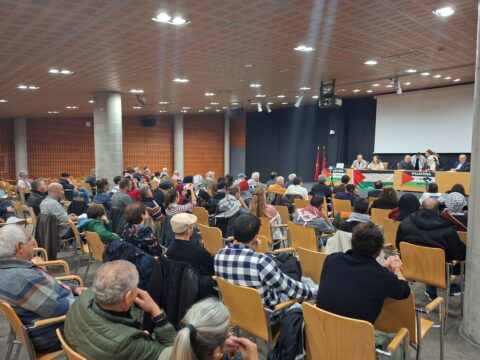An art project for children in Gaza shows the resolve of Palestinians, writes Alaa Salamah
Inside a small tent in the Deir- al Balah district of Gaza, five volunteers working in the arts have tried to create a space where children can express their emotions and imagination. Amid war Palestinian children are finding respite as they gather in circles to talk, laugh, draw, paint and create stories.
Haneen Koraz, an artist and project leader, said,” This initiative was conceived due to our passion to do something useful for the children and break the monotony of life under siege.”
Deir al Balah district is one of the areas where people have set up refugee camps, as it is said to be a “safe zone”.
Yet the area has still been subjected to bombing and shelling. According to Diab al-Jarro, the municipality’s head, the number of displaced people in the Deir al Balah region has reached more than half a million.
Haneen and her team went to a nearby shelter, which includes about 25 tents for displaced people, to discuss whether they could run animation workshops for kids. Finding the materials and tools for the workshop was challenging. The team needed stationery, projectors, special cameras, light rings, and laptops.
Haneen had left behind most of the tools in her home in Gaza City as she was displaced to her parents’ house.
But Haneen would not be stopped. With relentless persistence and continued efforts, she bought some tools with her money. She also requested that her colleagues and previous students, who had benefited from similar workshops, bring any available tools.
The children brought tables and chairs to sit out on. They also used a parachute attached to an aid drop. Haneen opened the workshops with games to attract and incite the children’s curiosity. She worked with them and brainstormed ideas to develop and fine-tune their stories through storyboarding and brainstorming techniques.
The intention was to make the kids come up with complete stories with clear messages and characters. Every child talked, drew and painted using papers, pencils, and paints. Then the team divided the children into groups, where every group had to do a task.
For instance, one group cut the characters from paper while others moved the characters and scenes using the stop-motion technique. Some recorded their voices to bring life to the different characters. Finally, they collected and organised all the scenes to form an animated film created by the children themselves.
“We listened to their stories as if we were listening to an adult in their 40s with abundant life experiences,” said Haneen.
“Most stories talked about war, displacement, bombing, hygiene problems in tents, diseases, their memories, and dreams.”
The children have created three films. Their first silent animated film is called “Tawabeer” which means queues. It sheds light on the suffering of displaced children’s daily lives.
These workshops taught the children how to use mobiles to take photos, move frames, and create animations using stop-motion technology. According to the organisers, the aim of such workshops is to help the children release their emotions and thoughts freely and alleviate their anxiety.
One participant, Lana Daka, said, “I want to learn more about the animation world. I feel happy and energetic when I move a character or record its voice.”
Another child said that this was the first time he was holding a paper and pencil after seven months of war.
The children are living in desperate conditions and are impacted by a deep level of trauma as the war has escalated. They are traumatised by the bombings and starvation. They have seen their friends and families die and schools and homes turn to rubble.
They have been denied food, medicine and vital aid and have been torn away from their original homes and lives.
Over 14,000 children have been killed in Gaza and 12,000 wounded. Around 1,750 are missing. According to Unicef’s estimate, about 500,000 children were already in need of mental health and psychosocial support in Gaza before 7 October. That number has now doubled to one million.
“We cannot separate human rights and psychological well-being,” said Rawya Hamam, community mental health specialist at Gaza Community Mental Health Programme (GCMHP). “All the rights are being violated.”
The horrors of war leave enduring impacts on children and can end up in post-traumatic stress disorder (PTSD).
Severe losses and disruptions in their lives lead to high rates of depression and anxiety. “The children suffer from constant worry and fear,” said Hamam.
“A lot of their normal routines have changed. Through my work and interactions with other families, I can see that many children have become silent, confused, shattered, and have a great decline in their attention spans.
“They also show higher levels of violence in their reactions and hyperactivity. All these are reflections of their built-in angst and fear.”
“A child told me that she could not forget her home, her room, or toys. She wished to get back to her home at least once.”
Using starvation as a weapon led to the death of 10 children living in the north of the Gaza Strip, according to the World Health Organization (WHO).
“In the welcome point where I work in Nuseirat camp, I came across a child who fled from the north to the south saying he did this to not be a burden to his father because he could not provide food for all his family,” Hamam said.
“Arts like drama and animation are therapeutic tools that can treat the trauma in war-affected children.
“Children can express their feelings, hopes and dreams for the future on paper, which will be helpful for their treatment by giving them a sense of control over their lives.
“Also connecting with groups enhances their social relationships and inclusion in society.” Hamam explained.”






